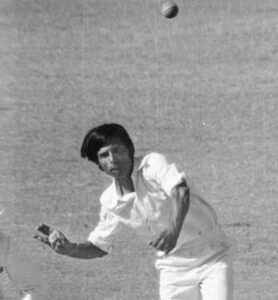Registered with the Registrar of Newspapers for India under R.N.I 53640/91
Vol. XXXI No. 8, August 1-15, 2021
That infamous Ranji final at Chepauk!
by Partab Ramchand

Padmakar Shivalkar – who turned the tide in Bombay’s favour. Courtesy: The Hindu.
It’s probably the most infamous Ranji Trophy final ever. Played on a Chepauk pitch that one writer said should be wrapped up and thrown into the Buckingham canal the match scheduled for five days was over in two days and a ball. Batsmanship remained a forgotten art as bowlers reveled on the surface and as many as 27 wickets fell on the second day.
It was with a good deal of confidence that Tamil Nadu approached the title clash against Bombay in April 1973. After topping the South Zone league table they defeated Railways in the quarterfinals at Chepauk and then most unexpectedly stunned hot favourites Maharashtra at Poona. Against that Bombay were the oft-crowned champions and were in the midst of a glorious run wherein they had won the trophy for 14 successive years. Also they had got the better of Tamil Nadu on all six occasions that the teams had met in the tournament.
Tamil Nadu reckoned that their best chance to beat Bombay was to prepare a wicket suited to their star spin duo of S. Venkatraghavan and V.V. Kumar. Throughout the season the two had performed gallantly to cover up for some abysmal batting performances. What the authorities overlooked was that Bombay too had a first rate spin bowler in Padmakar Shivalkar who could make the ball ‘talk’ on such a surface especially as Tamil Nadu’s batting was weaker than Bombay’s. And indeed it was Shivalkar who emerged as the wrecker-in-chief and match winner.

S. Venkatraghavan. Courtesy: The Hindu.
On the opening day, Kumar and Venkatraghavan came out with full credit in bowling out a strong Bombay outfit for 151. The batting line-up was virtually an Indian one as it read Sunil Gavaskar, Ramnath Parkar, Ajit Wadekar, Dilip Sardesai, Ashok Mankad and Eknath Solkar. But the two got five wickets each and with Tamil Nadu 62 for two in reply at stumps the home crowd went back happy. And heartened by their good show a bigger crowd turned up for the second day’s play. But at the end of a dramatic day Bombay had practically won the trophy again.
First Tamil Nadu collapsed sensationally to 80 all out with Shivalkar proving to be unplayable. In a deadly spell of 41 balls the left arm spinner took seven of the eight wickets that fell for only ten runs finishing with innings figures of eight for 16. Michael Dalvi (21) and Abdul Jabbar (29) who added 56 runs for the third wicket were the only batsmen to reach double digits with five players out for ducks. But now it was Bombay’s turn to face the heat on an increasingly crumbling surface. They were 62 for six before Ajit Naik and Sudhir Naik added 51 runs for the seventh wicket. However from 113 for six Bombay slid sharply to 113 all out thanks to a dramatic spell by medium pacer B. Kalyanasundaram. The bespectacled bowler had the spectators cheering by taking the last four wickets at the same score including a hat trick. This gave him a triple distinction for it was the first hat trick ever in the Ranji Trophy by a Tamil Nadu bowler, the first against Bombay and the first in a Ranji Trophy final.
The joy of the spectators however was short lived. Set to get 185 for a win on a surface that was by now turning square would be difficult but no one would have bargained for another dismal showing by the TN batsmen who by stumps were 61 for nine. Indeed but for Jabbar’s plucky 28 the match could have been over by the second day itself. This time the spoils were shared by Shivalkar and Solkar who took five wickets each with the former getting the last wicket with the only ball bowled on the third day. Shivalkar had the incredible match figures of 13 for 34 as Bombay completed a 123-run victory for their 15th successive triumph and 24th overall.
Interestingly enough following the severe criticism and the sensational happenings in the match the Tamil Nadu Cricket Association shortly afterwards dug up the pitch area, carried out extensive repairs and ultimately the wickets were re-laid.

